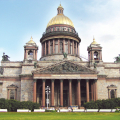ST. ISAAC'S CATHEDRAL
As one of the world's greatest monuments, it is a masterly as well as imperial tribute to the glory of Russia.
Dominating the imposing silhouette of the equestrian statue of Nicholas I, the Saint-Isaac Cathedral is a masterly as well as imperial tribute to the glory of Russia. It is one of the world's greatest monuments, and its gigantic size is hardly surpassed by that of Saint Paul's in London and Saint Peter's in Rome, and, more recently, the Ivorian basilica of Yamoussoukro. Its construction, entrusted to the Frenchman Montferrand, was the subject of one of the last great building sites in Saint Petersburg, mobilizing enormous manpower and resources. It took no less than 40 years, from 1818 to 1858, to build the main cathedral of Saint Petersburg. A few figures are enough to illustrate a gigantism where the technical challenge competes with aesthetics. Covered with a hundred kilos of gold, the dome with its colonnade rises to 102 m (8 m lower than the Invalides) and its diameter of nearly 22 m crowns the grandiose grey stone building flanked by free columns of impressive dimensions: some of them weigh up to 14 tons and measure 17 m. In addition, the 112 columns of the building are monoliths carved from marble quarries. It is easy to understand the difficulties encountered in hoisting such blocks of stone to the top of the monument. But this is only the visible part of the cathedral: the major challenge was to lay the foundations of this monument occupying one hectare of the spongy and loose soil of St. Petersburg. Groundwater was pumped out and then the soil was consolidated with a complicated system of wooden pilings - no less than 17,762! For the walls, the builders will extract huge blocks of granite from quarries in Finland, which will be transported by barge to St. Petersburg. A pharaonic construction site, on which more than 120,000 men will work, and which Peter the Great would probably not have disavowed..
The interior of the cathedral is up to the task: the richness of the decoration contrasts with the austere sobriety of the exterior façade, even if it obeys the same requirement of gigantism and technical overkill. Under the dome decorated with a fresco painted by Brullov and Bassin, frescoes, polychrome marbles and other precious materials are juxtaposed in a colourful and solemn decoration: columns of green malachite, lapis lazuli or porphyry support the building with walls covered with some 200 canvases, mosaics and frescoes representing saints. Finally, Saint-Isaac is adorned with a superb iconostasis, the creation of which involved some twenty artists. With a capacity of 10,000 faithful, the cathedral, whose luxury and profusion of works of art were more suitable for a museum than a place of worship, was transformed into a museum in 1930; from there to making it a museum of secularism, there was however a margin, which the high priests of Soviet culture did not hesitate to cross. The saints adorning the walls became the apostles of this temple of secularism, until Gorbachev opened the kingdom of heaven to them once again, in this cathedral which has regained its serenity and combines without any friction the vocation of a place of worship and a museum. Closer to the sky too, the 43-metre-high colonnade offers an interesting panoramic view of St Petersburg. You reach it by the staircase to the right of the main entrance.
Did you know? This review was written by our professional authors.
Members' reviews on ST. ISAAC'S CATHEDRAL
The ratings and reviews below reflect the subjective opinions of members and not the opinion of The Little Witty.









